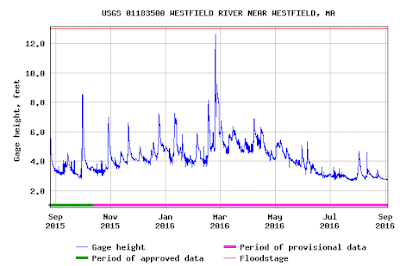 |
| Westfield River |
The guidebook to the M-M trails says that
"MA 187 is the common end point of section 2. Thru-hikers wanting to avoid the deep ford of the Westfield River will need to hike a long road walk." And so MA 187 is where I ended my last hike.
 |
| The part that is usually skipped by Section hikers at Robinson State Park |
Back home, though, I began to rethink this decision. We're in a major drought, so the river should be low. I verified this by checking a page from the National Weather Service for the USGS
Westfield River Streamgage out of Westfield. Here's a screen shot:
 |
| Water depth at gauge is 2.8 ft |
It shows the water level at the streamgage was 2.8 feet. But what is the water depth at the ford? I would assume any ford is shallower, that's why it's a ford. I stumbled across page where hiker described the water being up to his mid-thighs at the crossing. I then found historic data for the streamgage on a
USGS page. On that page, you can enter a range of dates to generate a hydrograph. Here's one for the past year:
From that graph, it was clear that the river depth at 2.8 feet was very, very low. It looks like it's normally about four or five feet deep at the streamgage, spiking after rains by a couple feet, in some cases more (it was over 12 feet deep in March).
 |
| Robinson State Park |
Confident the river would be no higher than mid-thigh, I threw an extra pair of sneakers in my pack I went back to MA 187 to follow the trail through Robinson State Park. The first part was lovely and easy to follow, following the top of the river bluff. And to think I nearly skipped this!
I missed where the M-M turns left off of the main path to head down the river, and had to use the gps to bushwhack down to the trail. I mumbled a statement of gratitude to the guy who posted his gps track online. As the trail dipped down to the shoreline it became extremely overgrown, although I was able to follow it (barely). Don't try to cross the river prematurely, although it's tempting. Follow the blazes to the end (gps track highly recommend so you know you're at the ford).
 |
| The ford. The shallows angle to the right. |
 |
| This way straight across is deeper. The shallows angle to the far right of the photo. |
With the low water, there was a nice gravel bar to linger and let the dog swim. The crossing looked pretty shallow. There were lots of freshwater clam shells along the shore, some dumped in piles where the muskrats left them.
 |
| Mussels shells, probably left by a muskrat |
After switching to my sneakers, I set out across the water. It was nice and only about a foot deep. Minnows swam about and there were some live clams in the bottom.
 |
| Live freshwater clam or mussel while crossing the Westfield River |
I was so focused on taking pictures and enjoying the water I suddenly found myself in water above the knees. The clear water was deeper than it looked (but still not a problem). I had headed straight across the river towards the blazed tree, while the shallows angled off to the right. I meandered over to the gravel bar ford and walked around. The entire way across, if you stay on the gravel bar, was at the most 1.5 feet deep. If you go straight across the river to the blaze, it's up to 3 feet deep, about the same as the USGS river gage.
 |
The blue line is the gravel bar, about 1.5 feet less than the USGS streamgage.
The red line is about the same depth as the USGS streamgage.
|
In summary, the USGS streamgage is a great resource to find out how deep the river crossing is. Take the reported river depth at the gauge and subtract 1.5 feet to estimate the shallowest possible crossing if you choose your footing carefully to follow the gravel bar, or just use the gauge depth to estimate the deepest water going straight across from blaze to blaze. Keep in mind there is also a pretty good current, and as the water gets deeper, it can really sweep you off your feet.
Crossing to the other side, I was greeted by some Allegheny Monkey Flower, a native of wet places that has flowers that look like they're grinning. Now I can start Section 3.
 |
| Allegheny Monkey Flower |












No comments:
Post a Comment